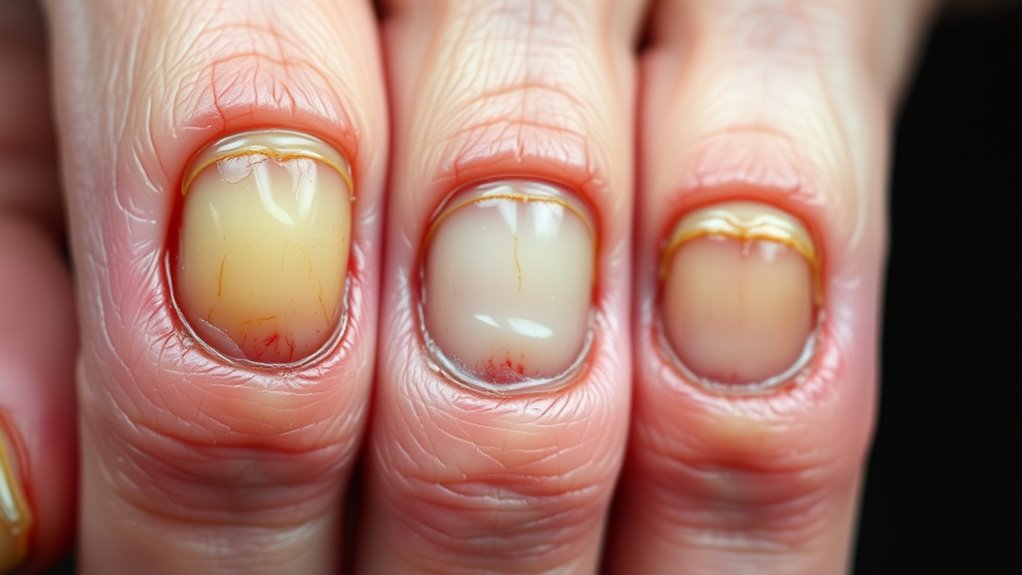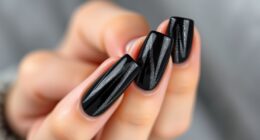If you notice persistent changes like cracks, ridges, discoloration, or painful swelling around your nails, don’t ignore them. Signs like pitting, dark streaks, or thickening can point to underlying health issues such as infections, nutritional deficiencies, or systemic diseases. If symptoms worsen, involve pus, or cause pain, see a doctor promptly. Recognizing these warning signs early can help prevent serious complications—continue exploring so you can better understand what your nails might be telling you.
Key Takeaways
- Persistent or worsening nail changes, such as color, shape, or texture, require medical evaluation.
- Signs of infection like redness, swelling, pus, or pain indicate the need for prompt treatment.
- Unusual discoloration, dark streaks, or rapid nail growth should be examined for serious conditions like melanoma.
- Nail pitting, thickening, or ridges may signal systemic health issues like psoriasis or thyroid problems.
- Immediate consultation is necessary if you experience significant pain, swelling, or if symptoms do not resolve with basic care.

Nail symptoms can serve as important clues to underlying health issues, signaling problems ranging from infections to nutritional deficiencies. If you notice any unusual changes in your nails, it’s essential to pay attention, as they might reveal more than just cosmetic concerns. For example, a nail infection can cause redness, swelling, and pus around the nail bed, often resulting in pain or tenderness. These infections are usually caused by bacteria, fungi, or yeast and tend to develop if your nails are frequently exposed to moisture or if you have minor cuts or injuries around your nails. Ignoring these signs can lead to more serious complications, so seeking treatment early is *vital*. Over-the-counter antifungal creams or prescribed medications are typically effective, but persistent infections may require medical intervention.
Beyond infections, changes in nail appearance can also be linked to nutritional deficiencies. Your nails can serve as a window into your overall health, especially reflecting deficiencies in nutrients like iron, zinc, biotin, or vitamins A and B12. For instance, brittle, thin nails that split easily might indicate iron deficiency anemia, while spoon-shaped nails, known as koilonychia, could signal iron deficiency or other nutritional issues. Similarly, ridges running vertically along the nail surface can sometimes be associated with aging but may also suggest deficiencies in essential nutrients. If your nails appear unusually pale or discolored, it might be worth evaluating your diet or discussing blood tests with your healthcare provider to identify underlying deficiencies. Correcting these deficiencies through diet or supplements often improves nail health and overall well-being. Additionally, nail symptoms can sometimes indicate underlying systemic conditions, such as thyroid problems or lung diseases, making awareness of systemic health signs crucial.
You should also be alert to other nail symptoms like pitting, which can be a sign of psoriasis or eczema, or dark streaks under the nail, which may warrant immediate medical attention to rule out melanoma or other serious conditions. Changes in nail shape, such as curvature or thickening, can also indicate systemic health issues, including thyroid problems or lung diseases. Remember, while some nail changes are harmless or related to minor injuries, persistent or worsening symptoms should never be ignored. If you notice significant or unusual alterations—especially if accompanied by pain, swelling, or other symptoms—you should see a healthcare professional. Early diagnosis and treatment can prevent complications, improve your nail health, and uncover potential underlying health issues that might otherwise go unnoticed.
Frequently Asked Questions
Can Nail Changes Indicate Internal Health Issues?
Nail changes can definitely be internal clues of underlying health issues. You might notice systemic signs like pale, brittle, or discolored nails, which could point to conditions such as anemia, fungal infections, or even liver problems. Pay attention to these signs, as they often reflect more than just surface issues. If your nails show unusual changes, it’s wise to see a healthcare professional for proper diagnosis and treatment, ensuring your overall health stays on track.
Are There Home Treatments for Concerning Nail Symptoms?
Thinking of your nails as the body’s report card, you might wonder if home remedies can help with concerning symptoms. While natural treatments like moisturizing, avoiding harsh chemicals, and maintaining good hygiene can improve minor issues, they aren’t a cure-all. For stubborn or worsening symptoms, it’s best to see a healthcare professional. Remember, some nail changes signal underlying health problems that require medical attention beyond home treatments.
How Quickly Should I See a Doctor for Nail Problems?
You should schedule an early appointment with a healthcare provider if your nail problems worsen quickly, show signs of infection, or don’t improve with home care within a week. For urgent symptoms like severe pain, swelling, or pus, seek an urgent consultation immediately. Prompt attention helps prevent complications and guarantees proper treatment. Trust your instincts—timely care can make a significant difference in your nail health.
Can Nail Symptoms Be Linked to Vitamin Deficiencies?
Oh, so your nails are throwing a tantrum? Turns out, they might be signaling nutrient deficiencies from dietary causes. Yes, your nail symptoms can be linked to vitamin and mineral gaps, like iron or biotin shortages. Instead of ignoring those strange lines or discoloration, consider it a call to action. Addressing these deficiencies can often improve nail health, but keep in mind, persistent issues warrant a professional check-up.
What Are the Risks of Ignoring Nail Abnormalities?
Ignoring nail abnormalities can lead to serious health issues, so you shouldn’t overlook them. Poor nail hygiene and unprofessional cosmetic treatments can worsen conditions or mask symptoms of underlying problems. If left unchecked, infections might spread, or you could develop more severe issues like fungal infections or nail loss. Regularly checking your nails and seeking medical advice when needed helps protect your overall health, preventing complications from worsening.
Conclusion
Don’t ignore changes in your nails—don’t ignore pain, discoloration, or unusual shapes. Pay attention to your nails, listen to your body, and seek help when symptoms persist or worsen. Recognize the signs, understand the risks, and prioritize your health. By staying alert, by staying informed, you can catch problems early, prevent complications, and maintain healthy nails. Because your nails tell a story—a story you shouldn’t ignore.









